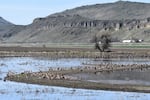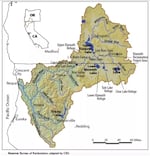Increased water allocation to the Klamath Basin wildlife refuges is helping mitigate a summer botulism outbreak that has resulted in the deaths of thousands of migratory birds.
On Aug. 17, the Bureau of Reclamation started flowing water to the Tule Lake and Lower Klamath National Wildlife Refuges to help mitigate an outbreak of avian botulism. Thousands of ducks, waterfowl, and shorebirds at the Tule Lake Refuge have died from the disease this month. Both refuges are part of the Klamath Basin Refuge Complex straddling the Oregon-California border near Klamath Falls.

Geese enjoy a respite at Tule Lake National Wildlife Refuge in spring 2024, months before an outbreak of botulism in the Klamath Basin has killed thousands of migratory birds.
Juliet Grable / JPR
Since the outbreak began in mid-August, refuge staff have been finding up to 500 dead birds per day in Sump 1A, the largest water body in the Tule Lake National Wildlife Refuge. John Vradenburg, supervisory biologist for the Klamath Basin Refuge Complex, estimates that about 20,000 birds have died so far, many of them ducks like pintails and green-winged teals.
The circulating water and increased volumes are helping prevent an even greater disaster, says Vradenburg, as sick and dead birds are concentrated in fewer areas.
“We are still seeing sick birds where the water is not moving, but some improvements where there is good flow and places where the water is getting deeper,” says Vradenburg.
A rehab hospital to treat sick birds is being operated by the nonprofit Bird Ally X in partnership with Ducks Unlimited. The facility wasn’t operating earlier because refuge staff were awaiting test results on dead birds sent to the USGS National Wildlife Health Center in Madison, Wisconsin.
After dead grebes tested positive for Highly Pathogenic Avian Influenza in July, Vradenburg feared they were dealing with a dual outbreak of botulism and “bird flu.” They couldn’t risk treating birds possibly infected with HPAI in a confined area, since the virus can be transmitted to humans. So far, samples have only tested positive for botulism.
The botulism toxin is produced by a soil-borne bacterium and flourishes in warm, shallow and stagnant water.
The Bureau of Reclamation is responsible for allocating water to irrigators and to maintain levels in Upper Klamath Lake and flows on the Klamath River. In 2024, the refuges received more water than they have in recent drought years, drawing an abundance and diversity of birds not seen for decades. Reclamation was even able to send additional water to farms and the refuges to ensure safe conditions downstream while deconstruction of three dams downstream on the Klamath River took place.
In summer, as flows were curtailed and air temperatures rose, wetlands on the refuges drained and warmed. In July, tribes, waterfowl advocacy groups, and irrigators warned Reclamation that conditions were ripe for botulism to flourish and urged the agency to deliver water to the refuges. In August, after birds had begun dying at Tule Lake, 16 conservation groups, including many Audubon chapters, sent a letter urging the agency to release water to help mitigate the outbreak.

A map of the Klamath Basin with wildlife refuges.
Courtesy of Bureau of Reclamation
In a statement provided to Jefferson Public Radio, the U.S. Fish and Wildlife Service thanked Reclamation for directing water and acknowledged “sustained inflow” as “one of the most valuable tools for addressing a botulism outbreak in birds.” In addition, the water flowing into Lower Klamath refuge has stabilized wetland levels there, giving rescuers a disease-free location to release birds that are treated in the rehab hospital.
Vradenburg remains hopeful this year’s botulism outbreak won’t be a reprise of 2020’s deadly event, when 60,000 ducks, geese, and other birds perished.
Karl Wenner, who co-owns Lakeside Farms adjacent to Upper Klamath Lake, worries that with temperatures climbing back into the 90s this week, the outbreak could still “hit a crescendo.”
“I appreciate that Reclamation has released more water, and the farmers have done a fantastic job coming up with creative ways to get water to the refuges, but a little bit of water at this time is not enough,” says Wenner. “This is a systemic problem that requires more creative thinking and flexibility on everyone’s part to get this ecosystem back to functioning.”
Along with the short-term mitigating flows, the Bureau of Reclamation says it is “supporting and engaging in a number of collaborative forums where Tribes, water managers and stakeholders are working together to develop a longer-term operational plan to meet multiple needs with limited water supplies.”
Among the strategies they are considering is flowing water from through and within the Klamath Project, the irrigation system that supplies water to farmers as well as the Tule Lake and Lower Klamath refuges.
Mark Hennelly, vice president of advocacy at California Waterfowl Association, says that flowing water from Upper Klamath Lake, through the farms and refuges and back to the Klamath River would improve water quality in the river and create permanent and semi-permanent wetland habitat that mimics how the Klamath Basin used to function naturally, before the massive irrigation project remade it. These wetlands could also be used to support struggling populations of endangered suckers (c’waam and koptu), says Hennelly.
“If we could get more water to the refuges, but do it in a way that we help endangered fish, that would be ideal,” says Hennelly. “Certainly too if we can create more reliability for the farmers.”
With so many demands on a limited water supply, such a solution requires more study, along with funding. Some of that funding could come from the state.
In November, California voters will weigh in on Proposition 4, The Safe Drinking Water, Wildfire Prevention, Drought Preparedness, and Clean Air Bond Act of 2024. If passed, it would authorize $10 billion in funding for “environmental and climate projects,” including $25 million for the Klamath refuges.
Hennelly would also like to see the updated Biological Opinions – documents that guide environmental decision making in the area for threatened coho salmon and endangered suckers – address the needs of the refuges and their importance to birds.
“We’ve got to get past single species management and look more towards an ecosystem-based approach,” says Hennelly. “That’s what’s going to have more consensus with the stakeholders and benefit multiple species.”
Clarification: This story has been updated to say Bird Ally X, in partnership with Ducks Unlimited, operates a rehab hospital in response to the botulism outbreak.


